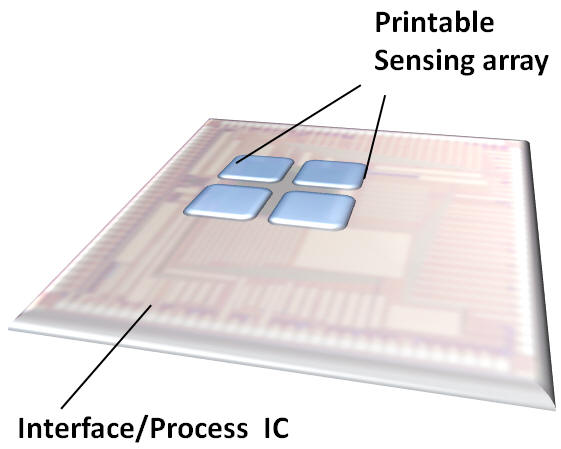An Inkjet-Printable Node with Olfactory-Sensing for Environmental Monitoring
PI: Prof. Chih-Ting Lin
Intel Champions: Ms. Melissa Cowan and Ms. Ramune Nagisetty
Following the advancement of communication techniques, the machine-to-machine (M2M) network technology has become an important field to be developed and implemented. This technology enables intelligent connections within groups of devices and systems. It promotes the smart environment for the next generation. In the M2M system, it comprises three essential elements: physical devices, information-carrier networks, and back-end servers. Traditionally, most of M2M researchers concentrate their works on networking algorithms and services. The issues of physical device especially for M2M have not been addressed. As a consequence, the implementation of M2M system is limited in the proof of concept without stepping further into products and businesses.
To promote M2M sensor network systems, there are two major problems: scalability and complexity. Traditionally, researchers and developers focus on the extreme cases to solve these problems, i.e. pure software solution to improve protocol and pure hardware solution to boost data rate. Under the constraint of power consumption, it is hard to solve these problems without considering the theme including both hardware and firmware. Therefore, we propose to conquer the problems by integrating two elements: (a) low-power sensing device; (b) low-power local signal process unit. Furthermore, we plan to integrate these two essential elements into a single chip to increase the chip value and reduce the sensor-on-chip manufacturing cost.
 Figure 1. The schematic of proposed sensor-system-on-chip
Figure 1. The schematic of proposed sensor-system-on-chipThe goal of this sub-project is to develop a low-power heterogeneous sensor-system-on-chip for M2M network system as shown in Fig. 1. This integrated sensor chip architecture can be used in many applications. For instance, human-centric smart living environment requires gaseous/chemical monitoring for safety and comfort. To have intelligent and comfortable environments, traditional point-sensing systems regulated by safety law are insufficient. It is necessary to have the sensor network to obtain the detail spatial information to address human-activities. Moreover, this sensor network needs complicated infrastructures, wired networks and centralized data fusion systems, to handle the considerable quantities of sensor information. To address these demands in M2M network, the proposed sensor chip will simultaneously measure 4 kinds of gaseous chemicals, i.e. humidity, temperature, carbon dioxide, carbon monoxide, and volatile organic compounds (VOCs), to demonstrate its capabilities in environmental factors. Utilizing low power sensor data process elements (SDPEs) on-chip, the cross-sensitivity of different sensing materials can be eliminated to achieve accurate measurements. This local process capability will also help to reduce the demand of data transmission from each sensor node. As a result, the network scalability and complexity can be enhanced.
Members





